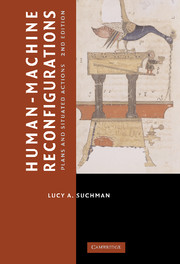Book contents
- Frontmatter
- Contents
- Acknowledgments
- Preface to the 2nd Edition
- Introduction
- 1 Readings and Responses
- 2 Preface to the 1st Edition
- 3 Introduction to the 1st Edition
- 4 Interactive Artifacts
- 5 Plans
- 6 Situated Actions
- 7 Communicative Resources
- 8 Case and Methods
- 9 Human–Machine Communication
- 10 Conclusion to the 1st Edition
- 11 Plans, Scripts, and Other Ordering Devices
- 12 Agencies at the Interface
- 13 Figuring the Human in AI and Robotics
- 14 Demystifications and Reenchantments of the Humanlike Machine
- 15 Reconfigurations
- References
- Index
- Frontmatter
- Contents
- Acknowledgments
- Preface to the 2nd Edition
- Introduction
- 1 Readings and Responses
- 2 Preface to the 1st Edition
- 3 Introduction to the 1st Edition
- 4 Interactive Artifacts
- 5 Plans
- 6 Situated Actions
- 7 Communicative Resources
- 8 Case and Methods
- 9 Human–Machine Communication
- 10 Conclusion to the 1st Edition
- 11 Plans, Scripts, and Other Ordering Devices
- 12 Agencies at the Interface
- 13 Figuring the Human in AI and Robotics
- 14 Demystifications and Reenchantments of the Humanlike Machine
- 15 Reconfigurations
- References
- Index
Summary
My aim in this book is to rethink the intricate, and increasingly intimate, configurations of the human and the machine. Human–machine configurations matter not only for their central place in contemporary imaginaries but also because cultural conceptions have material effects. As our relations with machines elaborate and intensify, questions of the humanlike capacities of machines, and machinelike attributes of humans, arise again and again. I share with Casper (1994), moreover, the concern that the wider recognition of “nonhuman agency” within science and technology studies begs the question of “how entities are configured as human and nonhuman prior to our analyses” (ibid.: 4). Casper proposes that discussions of nonhuman agency need to be reframed from categorical debates to empirical investigations of the concrete practices through which categories of human and nonhuman are mobilized and become salient within particular fields of action. And in thinking through relations of sameness and difference more broadly, Ahmed (1998) proposes a shift from a concern with these questions as something to be settled once and for all to the occasioned inquiry of “which differences matter, here?” (ibid.: 4). In that spirit, the question for this book shifts from one of whether humans and machines are the same or different to how and when the categories of human or machine become relevant, how relations of sameness or difference between them are enacted on particular occasions, and with what discursive and material consequences.
- Type
- Chapter
- Information
- Human-Machine ReconfigurationsPlans and Situated Actions, pp. 1 - 7Publisher: Cambridge University PressPrint publication year: 2006

